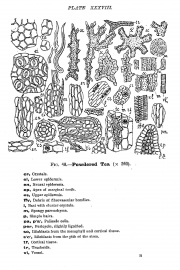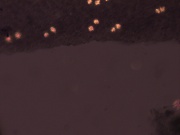|
|
| Line 1: |
Line 1: |
| − | {{Microscopy | source=French Pharmacopoeia
| |
| − | | description=Tea (leaf) (''Camellia sinensis'')
| |
| − | | color=greyish-green
| |
| − | | scent= faint
| |
| − | | flavor= pungent and astringent
| |
| − | | characteristics=A transverse section of Green Tea exhibits a proeminent rib on the lower surface. Stained with alum-steeped carmine-green reagent, the main rib exhibits a libero-ligneous arc of secondary structure surrounded by lignified pericyclic fibres. The lower epidermis of the lamina is stomatiferous and bears thick-walled, flexuous, conical, unicellular protective hairs. The mesophyll, asymmetrical heterogeneous, comprises a single layer of palisade parenchyma and several layers of spongy parenchyma which includes large ramified sclerites which can extend from one epidermis to the other. Twin crystals of calcium oxalate are present in all parenchyma.
| |
| − |
| |
| − | Examined under a microscope in the lactic reagent R, powdered Green Tea (300), greyish-green in colour, exhibits fragments of lamina comprising the non-stomatiferous upper epidermis, the chlorophyllian palisade parenchyma and the spongy parenchyma included in which are large bright yellow ramified sclerites and twin crystals of calcium oxalate. The lower epidermis comprises stomata surrounded by 3 or 4 adjoining cells and flexuous, unicellular protective hairs with conical ends and thick walls.
| |
| − | .}}
| |
| − |
| |
| − | {{Microscopy | source=Amy Brush Traditional Medicinals
| |
| − | | mainimage=HGRNOA 18974 twin ca oxalate, 200x.jpg
| |
| − | | description=Green Tea (''Camellia sinensis'')
| |
| − | | characteristics=Twin calcium oxalate crystals, polarized. 200X glyercin : deionized water solution.
| |
| − | | }}
| |
| − |
| |
| | {{Microscopy | source=Greenish, H. et. al. (1908) An Anatomical Atlas of Vegetable Powders | | {{Microscopy | source=Greenish, H. et. al. (1908) An Anatomical Atlas of Vegetable Powders |
| | | mainimage=12 0206 Camellia sinensis plate from Greenish et al Anotomical Atlas.JPG | | | mainimage=12 0206 Camellia sinensis plate from Greenish et al Anotomical Atlas.JPG |
| Line 34: |
Line 18: |
| | * The ''stomata surrounded by tangentially elongated cells.'' | | * The ''stomata surrounded by tangentially elongated cells.'' |
| | * The ''calcium oxalate in cluster crystals.'' }} | | * The ''calcium oxalate in cluster crystals.'' }} |
| | + | |
| | + | |
| | + | {{Microscopy | source=Amy Brush Traditional Medicinals |
| | + | | mainimage=HGRNOA 18974 twin ca oxalate, 200x.jpg |
| | + | | description=Green Tea (''Camellia sinensis'') |
| | + | | characteristics=Twin calcium oxalate crystals, polarized. 200X glyercin : deionized water solution. |
| | + | | }} |

